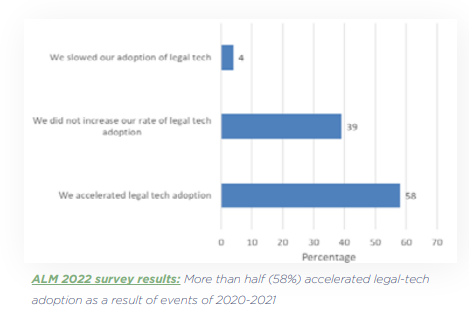Inside HBR’s 2022 Annual Benchmarking Survey: The Outlook for Legal Technology
Anticipating economic pressures and evolving demand in 2023, law departments are shifting focus to the upcoming law firm rate review cycle and more strategic legal technology advances.
As the leading source of benchmarking data for corporate law departments, the annual HBR Law Department Survey has been delivering data on legal spending, staffing, technology, outside counsel management, and compensation for 18 years. This year’s report featured 162 participating companies representing over 15 industries, revealing a common thread of new economic pressure and a focus on lean, strategic operations across markets. Dive into the following survey highlights and our top takeaways regarding legal technology innovation in 2023.
From Progress to Pressure: How 2022’s Outlook Shifted
HBR’s Law Department Survey revealed that most law departments maintained positive hiring outlooks and demand growth in 2022. Consider the following statistics recorded from Q3:
- 57% of survey respondents reported anticipating an increase in headcount
- 71% of departments reported anticipating a rise in internal legal spending (up from 55% last year)
- 46% of in-house teams (up from 36% last year) reported expecting rising outside counsel spending
- 70% of law departments anticipated an increase in demand for regulatory services (up from 56% last year)
In more recent months, however, the survey unveils that economic uncertainty has impacted departments’ outlook for 2023, pushing them to proceed more cautiously.
In HBR’s most recent Sounding Board Series in the fall, 79% of participating law department leaders indicated that cost reduction mandates were now a top challenge heading into the 2023 planning process. Other top-of-mind concerns included navigating changing demand/volume of work (69%) and macro-economic factors (e.g., recession planning) (64%).
Workflow Automation, Analytics, and Legal Technology Expected to Prevail
Before the economic pressure and increased demand to operate lean and strategically spend in 2023, law departments were already starting to uncover ways to conserve resources and maximize productivity through strategic technology investment. HBR’s survey reveals that in 2022, legal automation and analytics gained serious traction:
- 60% of departments reported implementing a legal data analytics tool (up from 52% last year)
- 26% indicated using artificial intelligence for at least one use case (up from 15% last year)
- 30% of departments indicated consideration of legal service request tools (up from 19% last year)
- 29% expressed interest in robust workflow automation tools (up from 19% last year)
Moving forward, 51% of participating departments expect this trend to continue and anticipate an increase in their legal technology budget as a result. More specifically, the top technologies participating departments are considering or planning implementation on include:
- Legal Service Request (30%)
- Workflow (29%)
- Contract Management (24%)
“We are seeing many departments that have already adopted core legal technology (e-billing, document management, etc.) turn their focus to emerging tools related to workflow and analytics that can help align legal with the innovation trends we are seeing take off in the corporate world more broadly. Strategic investment in these types of technology can also improve efficiency and drive data-driven decision-making, which will become increasingly important as economic pressures impact law departments.” — said Lauren Chung, chief practice officer and survey editor at HBR.
A New Era of Legal Technology Innovation
A survey conducted by ALM on Legal Trends for 2022 confirmed that companies doubled down on innovation, with 40% of respondents claiming to use technology to share or expand legal-vetted processes across other business units. Yet, only 12% of survey respondents agreed that their legal tech stacks were “very integrated,” and an overwhelming majority found plenty of room to improve.

That’s because too many teams make the mistake of turning to quick-fix point solutions, which usually result in more harm than good – incompatible features, custom code, no API integrations, etc. As companies expand and realize new business needs, they end up juggling vendor contracts and incompatible software features, eating up time and resources they don’t have, especially as economic pressure increases.
It’s not about doing a large-scale digital transformation overhaul; it’s about strategically investing in the right foundation to help you get the most value out of the processes and resources you already have.
To keep technology investment strategic, forward-thinking departments are turning to single-platform partners for their full breadth of legal solutions — a one-stop-shop of solutions spanning matter management, spend analytics, eBilling, and legal hold — all underpinned by no-code workflow automation and tech-forward contract management.
A platform approach makes it easy to begin — and optimize — the digital transformation journey with a foundation of intelligent SaaS workflow automation and flexible industry integrations that take the administrative lift off your team.
Please note that this recap is an approved summary of HBR’s original law department survey, which you can find here.
For those who did not take part in the survey this year, we hope that the takeaways are useful and encourage you to sign up for the survey in 2023! Please contact [email protected] for more information.
About HBR Consulting LLC
(HBR) provides law firms and corporate law departments with strategic guidance, operational improvement, and technology solutions that drive innovation while managing cost and mitigating risk. HBR’s proven combination of experience, relationships, and insights—spanning the legal ecosystem—delivers sustainable financial and competitive advantages for its clients.
To purchase the full results of the 2022 HBR Law Department and Compensation Survey with optional breakouts by industry, revenue size, law department size, and region, please contact [email protected].



